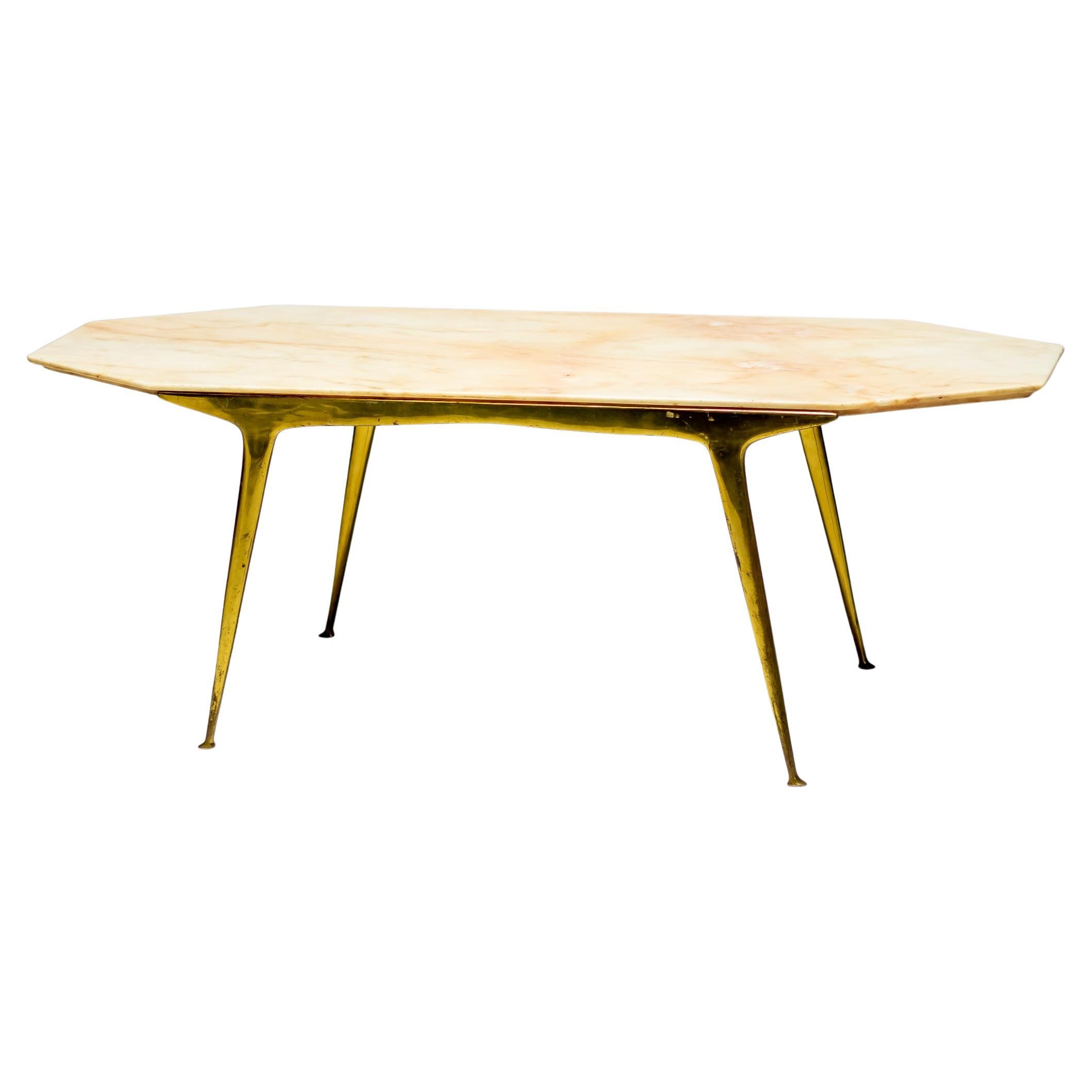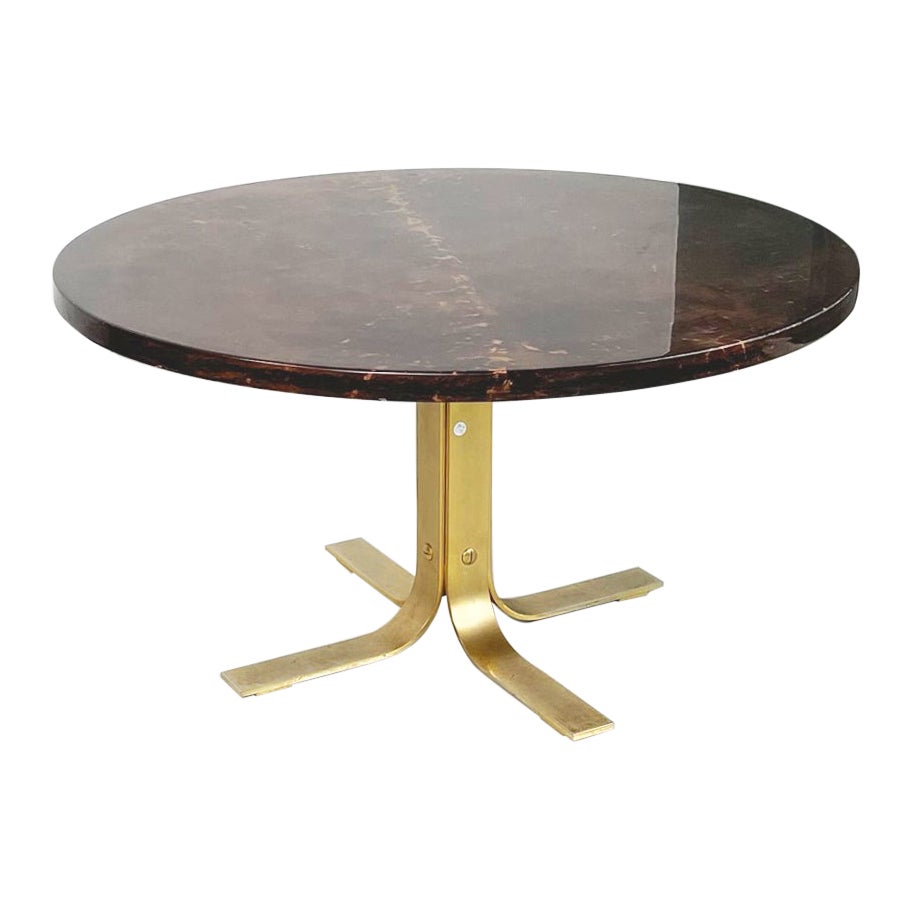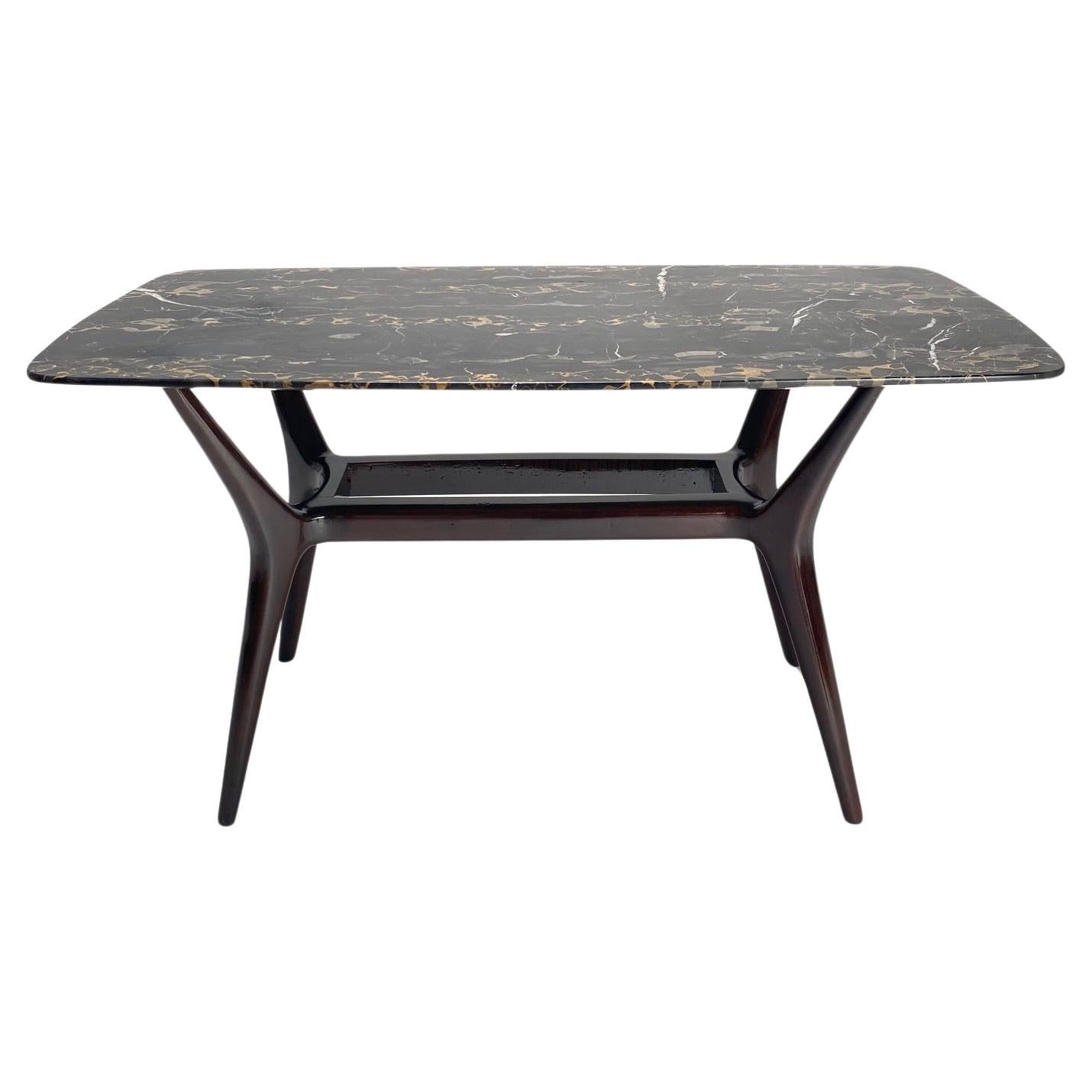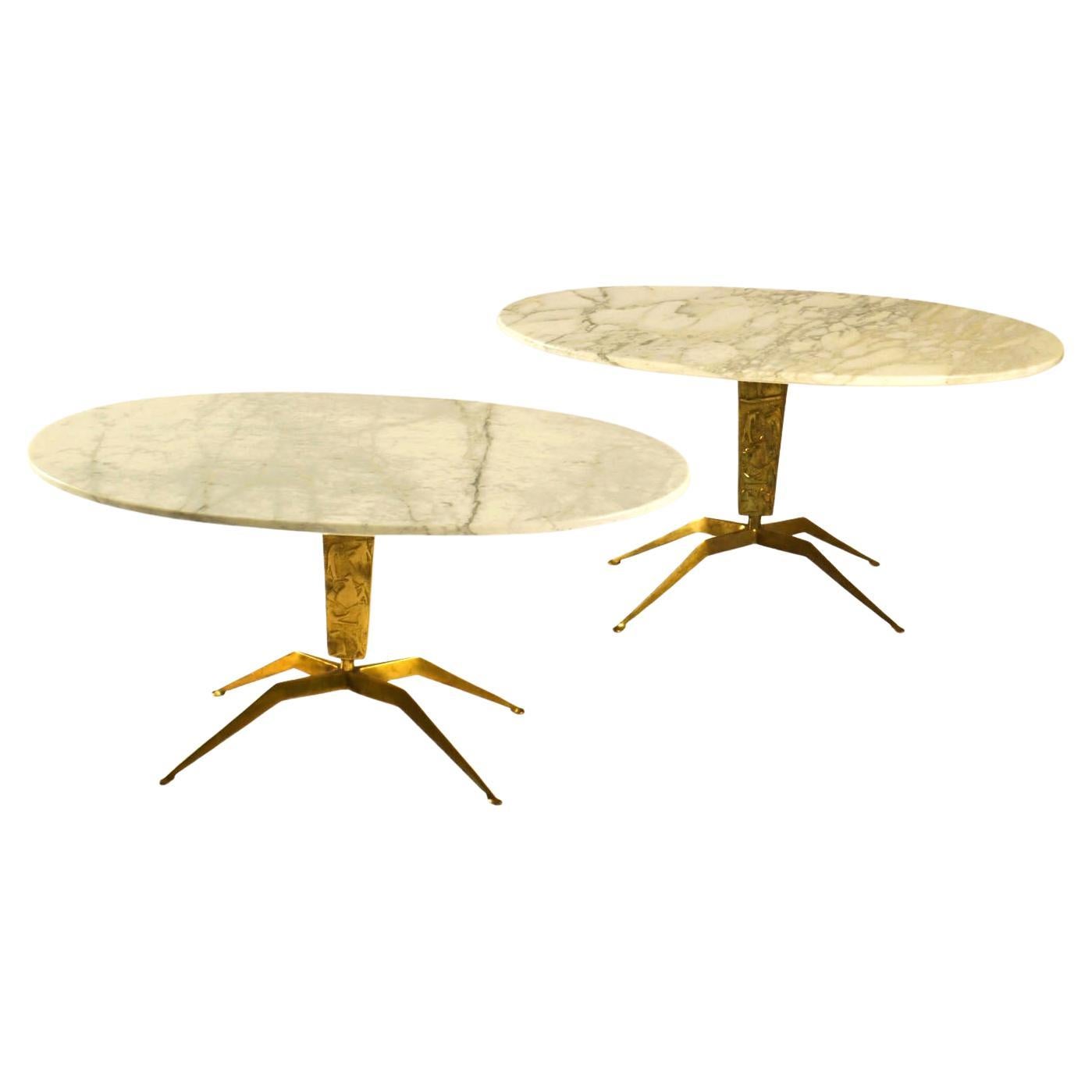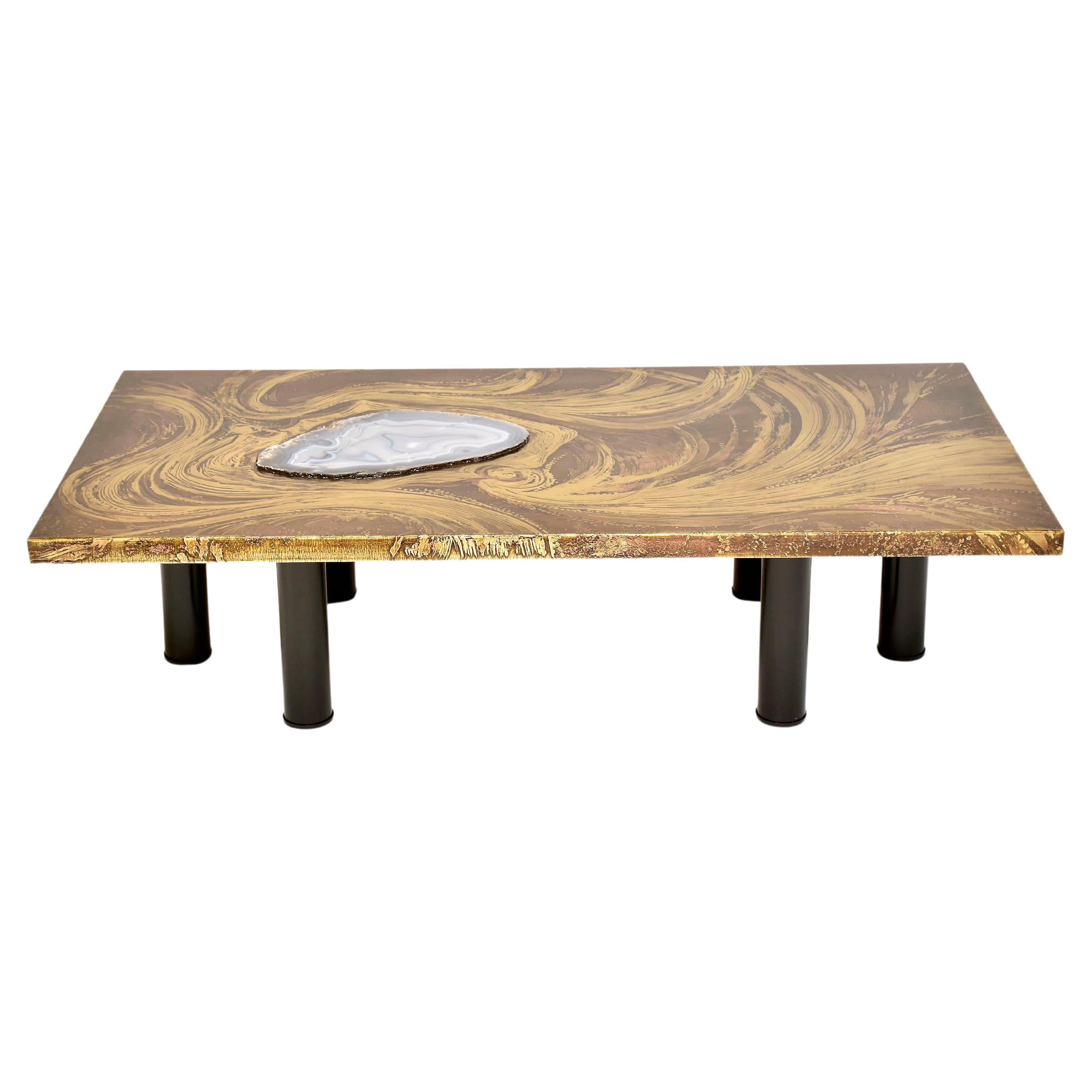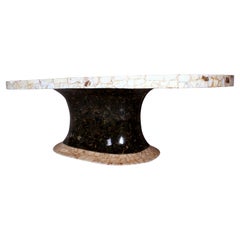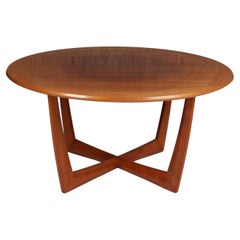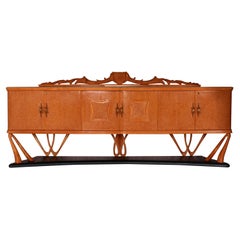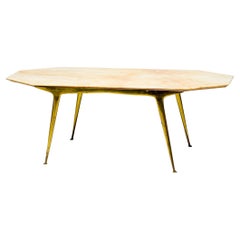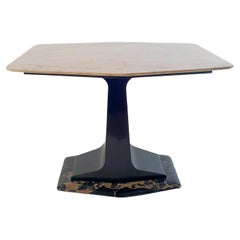Items Similar to Duilio " Dubé " Bernabe Italian coffee table Marble and Bronze Relief
Want more images or videos?
Request additional images or videos from the seller
1 of 9
Duilio " Dubé " Bernabe Italian coffee table Marble and Bronze Relief
$2,956.87per set
£2,190.60per set
€2,480per set
CA$4,050.76per set
A$4,494.66per set
CHF 2,354.40per set
MX$55,116.60per set
NOK 29,947.15per set
SEK 28,268.83per set
DKK 18,864.81per set
Shipping
Retrieving quote...The 1stDibs Promise:
Authenticity Guarantee,
Money-Back Guarantee,
24-Hour Cancellation
About the Item
It is our great pleasure to confirm that both the stand and the board are, in fact, original and remain in their original condition.
This rectangular coffee table was designed by Duilio Barnabé (also known as Dubè). The table is distinguished by an ivory marble top, which is supported by a cast brass base that has been sculpted to evoke the form of figures and is equipped with four spider legs and oval feet. The figures on the legs are abstracted in a style that is characteristic of the 1950s and narrate the tale of life.
For purposes of reference, I would like to cite Artnet (2011), which describes this coffee table by Duilio (Dubè) Barnabé as having been created in 1955 in Italy for Fontana Arte.
In terms of dimensions, the table measures 79 cm x 39 cm with a height of 44 cm. It features an original lacquered marble board (free of chips or cracks) that exhibits indications of wear and tear on the lacquered surface (flattening of the original lacquerwork), which definetely is not recommended for replacement.
~ The appeal of authentic furniture is unparalleled !
P.S.: I'm afraid there has been a misunderstanding. The offer refers to one coffee table, but due to technical reasons, it is listed as a set of four. Unfortunately, I am unable to change this.
NOTE:: In order to ensure the utmost safety and expediency in the shipping process, we will assume responsibility for organizing the shipping ourselves.
Please do not hesitate to request a shipping quotation.
- Creator:Duilio Dubé Bernabe (Maker)
- Dimensions:Height: 17.33 in (44 cm)Width: 70.48 in (179 cm)Depth: 15.36 in (39 cm)
- Sold As:Set of 4
- Style:Mid-Century Modern (Of the Period)
- Materials and Techniques:
- Place of Origin:
- Period:
- Date of Manufacture:1955
- Condition:Wear consistent with age and use.
- Seller Location:Landshut, DE
- Reference Number:1stDibs: LU8587237221332
About the Seller
5.0
Gold Seller
Premium sellers maintaining a 4.3+ rating and 24-hour response times
1stDibs seller since 2023
21 sales on 1stDibs
Typical response time: 4 hours
- ShippingRetrieving quote...Shipping from: Bodenkirchen , Germany
- Return Policy
Authenticity Guarantee
In the unlikely event there’s an issue with an item’s authenticity, contact us within 1 year for a full refund. DetailsMoney-Back Guarantee
If your item is not as described, is damaged in transit, or does not arrive, contact us within 7 days for a full refund. Details24-Hour Cancellation
You have a 24-hour grace period in which to reconsider your purchase, with no questions asked.Vetted Professional Sellers
Our world-class sellers must adhere to strict standards for service and quality, maintaining the integrity of our listings.Price-Match Guarantee
If you find that a seller listed the same item for a lower price elsewhere, we’ll match it.Trusted Global Delivery
Our best-in-class carrier network provides specialized shipping options worldwide, including custom delivery.More From This Seller
View AllMarble Oval Tulip Dining or Conference Table Muller's of Mexico with Brass Inlay
By Muller of Mexico
Located in Landshut, BY
The table is an exquisite and unique piece of craftsmanship, hand-made in the 1970s by Muller of Mexico. It is crafted from green and ebony colour marble, with a lined surface of ov...
Category
Vintage 1970s Mexican Mid-Century Modern Dining Room Tables
Materials
Marble, Brass
skandinavian modern huge round coffee table by KONDOR Möbel-Perfektion 1960s
By Kondor Möbel-Perfektion 1
Located in Landshut, BY
This item represents a significant chapter in the history of the German furniture industry.
A coffee table by KONDOR Möbel-Perfektion
This piece of furniture features a top layer of ...
Category
Vintage 1960s German Scandinavian Modern Coffee and Cocktail Tables
Materials
Wood, Walnut
One of a Kind Italian Midcentury Sideboard with Bar Cabinet a. Vittorio Dassi
By Vittorio Dassi
Located in Landshut, BY
Italian 1950s
one of a kind
BAR / SIDEBOARD
attributed to Vittorio Dassi
birch root veneer - solid birch "feet" - stained glass top - mirrored bar compartment - carved upper orna...
Category
Vintage 1950s Italian Mid-Century Modern Sideboards
Materials
Stained Glass, Birch, Burl
Midcentury Cocktail Bar Made in England a. Umberto Mascagni Drinks Bar Counter
By Umberto Mascagni
Located in Landshut, BY
This spectacular English Cocktail Bar is in amazing good condition - fully revised and rewired.
Its solid wooden body is veneered with Tola Wood.
(botanic name: Gossweilerodendron ...
Category
Mid-20th Century English Mid-Century Modern Dry Bars
Materials
Glass, Formica, Wood, Teak
an amazing Fulvio Bianconi MURANO very heavy (2.25KG) 1970s BOWL or ashtray
By Fulvio Bianconi
Located in Landshut, BY
This is an incredible piece of craftsmanship!
I was just 10 years old when my father, who worked in Milan where I grew up, bought this bowl in Venice together with a huge Fazzoletto...
Category
Vintage 1970s Italian Mid-Century Modern Barware
Materials
Glass
Italian BAR / COUNTER STOOL ~ TURQUOISE ~ 50s 60s Style Iron / Brass / Velvet
Located in Landshut, BY
Italian
TURQUOISE
BAR / COUNTER STOOL
TURQUOISE
1950s / 1960s style
Lacquered iron / Solid brass / Velvet / Upholstered
hq foam upholstered and kedered
Category
2010s Italian Mid-Century Modern Pedestals and Columns
Materials
Brass, Iron
You May Also Like
Italian Brass Coffee Table with Marble Top, 1960
By Gio Ponti, Carlo Mollino
Located in Dronten, NL
Very elegant Italian 1950's coffee table with a polished brass base and marble top.
Excellent Italian craftsmanship and still in wonderful vintage condition with just the right amoun...
Category
Vintage 1950s Italian Mid-Century Modern Coffee and Cocktail Tables
Materials
Marble, Brass
Midcentury Coffee Table with Marble Top and Base
By Cantu
Located in Albano Laziale, Rome/Lazio
Significant lacquered marble coffee table made in Cantu, Italy in 1959. Cantu was for a long time a centre for furniture production of importance designed by great designers such as ...
Category
Mid-20th Century Italian Mid-Century Modern Coffee and Cocktail Tables
Materials
Marble
$2,861 Sale Price
31% Off
Italian Modern Coffee Table in Wood, Parchment and Brass by Aldo Tura, 1960s
By Aldo Tura
Located in MIlano, IT
Italian Mid-Century Modern Coffee table in wood, parchment and brass by Aldo Tura, 1960s
Coffee table with round wooden top, covered in parchment with a dark brown finish. The 4-spo...
Category
Vintage 1960s Italian Mid-Century Modern Coffee and Cocktail Tables
Materials
Brass
Organic coffee table in the style of Gio Ponti, Marble, Italy 1950s
By Gio Ponti
Located in Argelato, BO
Rare and important Mid-Century coffee table with lacquered wood structure and thick veined black marble top.
Made in Italy in the 1950s in the style of the great architect and desig...
Category
Vintage 1950s Italian Mid-Century Modern Coffee and Cocktail Tables
Materials
Marble
Pair of Coffee Tables 'Dubè' atrb Duilio Barnabé Italy, Marble and Bronze Relief
By Fontana Arte, Duilio Barnabe
Located in London, GB
Pair of oval coffee tables with Carrara marble top supported by a sculpted cast brass base with a relief of figures is standing on four spider legs on oval feet. The figures on the l...
Category
Vintage 1950s Italian Mid-Century Modern Coffee and Cocktail Tables
Materials
Carrara Marble, Bronze, Cut Steel
Brass etched coffee table by Marc D'Haenens with agate inlay
By Marc D'haenens
Located in SON EN BREUGEL, NL
Stunning design coffee table by Belgian artist Marc D'Haenens.
Brass etched top with decor and blue agate inlay resting on 6 black legs.
Signed by the artist.
We bought the table fro...
Category
Vintage 1970s Belgian Mid-Century Modern Coffee and Cocktail Tables
Materials
Agate, Brass
More Ways To Browse
Italian Relief
Dube Fontana Arte
Duilio Barnabe
Oval Brass Spider Leg Coffee Table
Maison Jansen Rams Head Table
Midcentury Modern Lazy Susan Tables
Modern Asian Style White Coffee Table
Pagoda Coffee Table
Paul Mccobb Marble Top
Pink Marble Slabs
Pond Coffee Table
Poulsen Tile
Roger Capron On Sale
Round Cork Table
Round Shagreen Cocktail Table
Tessellated Fossil
Tree Bird Coffee Table
Verde Antigua
